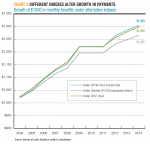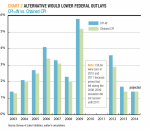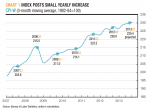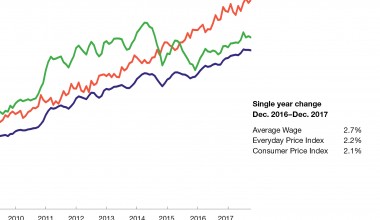Social Security to Rise Again
The increase is in line with the rise in the costs that seniors face. But Social Security reforms under discussion in Washington may reduce future COLAs.
The COLA is based on the Consumer Price Index for Urban Wage Earners and Clerical Workers (CPI-W), created by the Bureau of Labor Statistics. This is different from the Consumer Price Index for all Urban Consumers, the index widely reported as the measure of inflation. In practice however, the two indexes track each other closely.
The Social Security Administration determines the size of the COLA by comparing the CPI-W in the third quarter of the current year to the third quarter of the previous one. At the time of this writing, the CPI-W for the third quarter of 2013 is not yet available. The trend to date indicates that the COLA will be positive. (See Chart 1.)
The final data and the official announcement about next year’s Social Security COLA was scheduled to be released October 16. But the release date has been thrown into doubt by the October 1 shutdown of the federal government, which shuttered the government’s statistical agencies collecting the necessary data.
In future years, the way the COLA is computed may change. In his budget for 2014, President Obama has proposed that future COLA increases be based on the chained CPI rather than the CPI-W. The chained CPI rises more slowly than does the CPI-W. If the COLA for 2014 were computed using the chained CPI, it would be a bit lower—between 1.4 and 1.5 percent.
The same proposal was made in 2010 by the Bowles-Simpson deficit reduction commission. Neither the commission’s recommendations nor the president’s budget have been adopted by Congress. But the proposal for altering the COLA formula will keep surfacing in Washington because of its potential to reduce Social Security outlays by billions of dollars.
The difference may be nil this year, but it has been larger in the past. Had the COLAs been based on the chained CPI for the past 10 years, for example, they would be lower every year when there was a COLA, as shown on Chart 2. (COLAs were zero in 2010 and 2011 because prices fell during the 2008-09 recession and did not recover for some time.) The cumulative effect of 10 years of lower COLAs would be Social Security benefits that are 3 percent lower than they are today.
There are more than 55 million Social Security beneficiaries, with combined annual benefits approaching $800 billion. Reducing the COLA by even a fraction of a percentage point can produce substantial savings to the federal budget.
The reason the chained CPI usually increases more slowly than the CPI-W is hidden in the way these indexes are constructed. Any price index is a weighted average of prices of a vast array of products, ranging from tomatoes to medical care.
In the CPI-W, the weights are determined by how much of their incomes urban wage earners and clerical workers spend on each product. The spending patterns are determined by a survey conducted every other year. Between survey years, spending patterns are assumed to stay fixed, and the weights do not change.
But people do change their behavior, particularly in response to rising prices. When gasoline becomes much more expensive, people drive less. When the price of orange juice increases, as was the case in early 2011, people buy less orange juice and more of some other kind of juice. The chained CPI takes this into account. The weights used to average many prices into the chained CPI index change every month.
People tend to buy less of the goods that have increased prices and more of the goods with prices that are falling (or rising more slowly). Because of this, the overall increase in the chained CPI is always smaller than an increase in a fixed-weight index, like the CPI-W.
From the point of view of pure economics, a chained CPI is a more accurate measure of price trends because it better reflects the spending behavior of people. But this does not automatically make it the best index to use for Social Security COLAs.
The chained CPI may distort the effect rising prices have on quality of life. If rising fuel prices make utilities expensive and lead people to turn down the heat, for example, the data would show that people are choosing to reduce the amount of utilities they buy.
The chained CPI would account for this by assigning a lower weight to the cost of fuel and utilities in the overall index. The lower weight, in turn, would make the increase in the index smaller than it would have been if the weights remained unchanged.
The choice of the proper COLA is simple once its intended purpose is determined. Is it meant to reflect the cost of living for seniors after they adjust their spending for price increases? Then the chained index would be more accurate. Or is it intended to compensate seniors enough so that they would not have to turn down their heat when fuel prices rise? That would favor a fixed weight index like the CPI-W.
Citizens would be better served if politicians didn’t camouflage their calls for Social Security benefit cuts behind arcane price index arguments. With a clear idea about what we want the COLA to accomplish, selecting the appropriate index to use in computing it is simple. If the purpose of the COLA debate is actually to reduce government spending, a direct benefit cut would be more honest.
A More Precise Measure of Retirement Spending
An accurate COLA would be based on an index, whether chained or fixed-weight, that tracks the spending of retirees. Neither the chained CPI nor the fixed-weight CPI-W are based on the spending patterns of retirees, but rather on spending by all ages of urban residents.
An index that comes close to tracking the spending by retirees is the Experimental CPI for Americans 62 Years of Age and Older (CPI-E), which has been compiled by the Bureau of Labor Statistics since 1983. It shows that older Americans spend more on medical care and housing, but less on education, communication, food, and transportation, compared to urban wage earners covered by the CPI-W.
According to the CPI-E, the costs faced by older Americans have increased 1.6 percent in the 12 months to August. This means that the official COLA, which we estimate to be between 1.4 and 1.6 percent, will come close to compensating seniors for the rising cost-of-living this year.
The CPI-E has risen faster than the CPI-W in some years and slower in others. Overall, had the COLAs been based on CPI-E for the past 10 years, the increase in benefits would have been very similar to the increase that actually took place under the official COLA formula.
Chart 3 shows the growth of a monthly Social Security benefit of $1,000 for the past 10 years under alternative COLA rules. If the CPI-E had been used for COLA computation, a $1,000 monthly benefit in 2003 would increase to $1,299 by January 2014. Under the existing COLA rules that use CPI-W, it rose to $1,304. Had the COLA been based on the chained CPI, the benefits would increase only to $1,265 by 2014.








